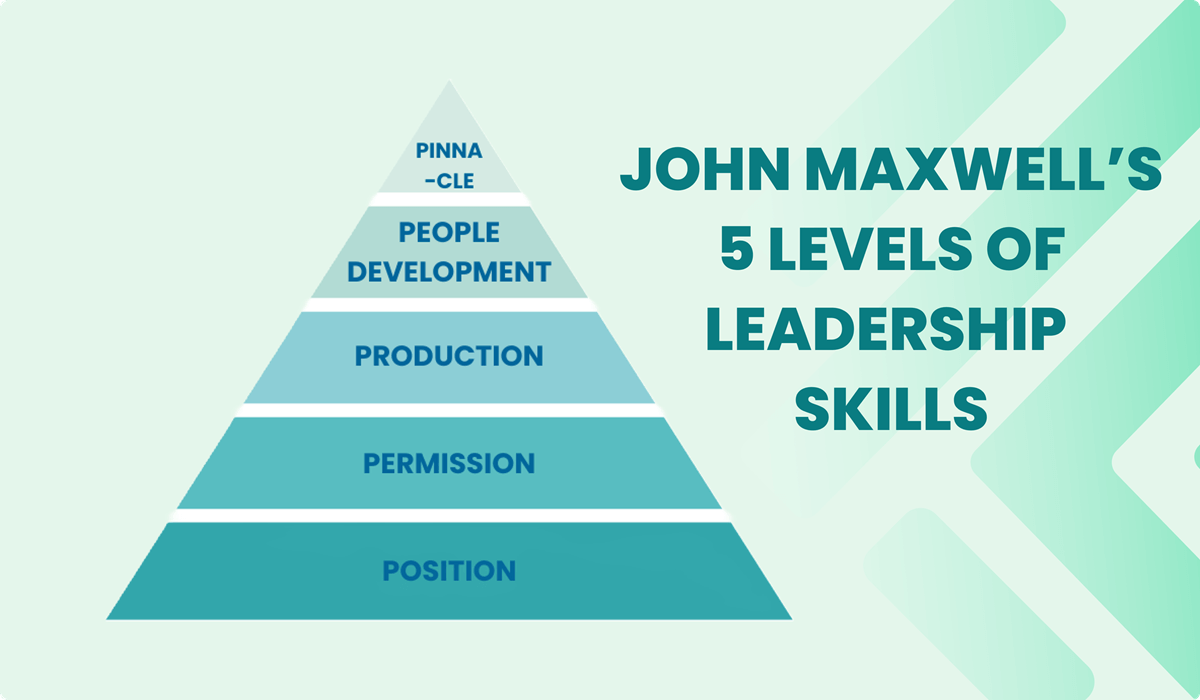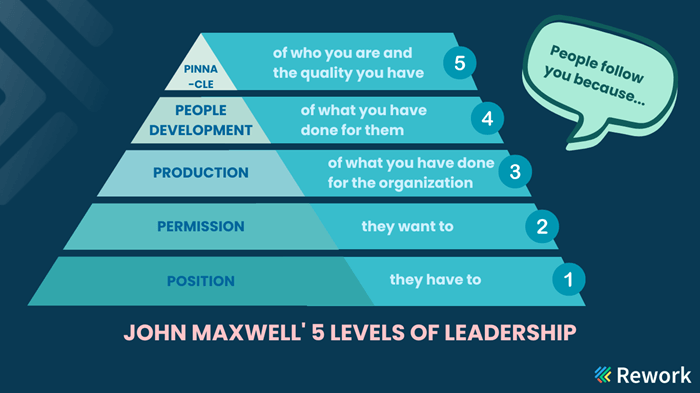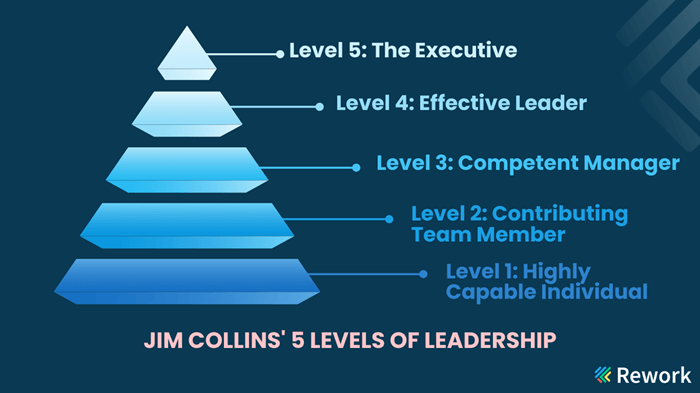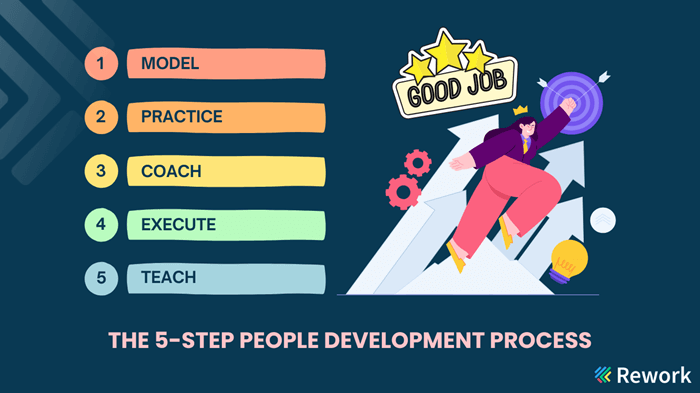Leadership
John Maxwell's 5 levels of leadership: Where are you standing?

The field of leadership science has seen the emergence of many theories and innovations, but John Maxwell's 5 Levels of Leadership stands out for its sharp reasoning and high applicability. If you're a manager wondering about how to advance your leadership career, then this article is for you. Before diving in, you may want to understand what leadership truly means and how it differs from management. Let's explore the details to find out where you are on your leadership journey and how to move forward.
What are the 5 levels of leadership?
About John Maxwell
Dr. John C. Maxwell is a renowned figure in leadership training, having inspired and guided over 6 million leaders worldwide. His influence spreads through his heartfelt books and speeches, making him a New York Times bestselling author with over 30 million copies sold.
His reputation is further solidified by prestigious awards:
- Ranked #1 Leadership Expert by the American Management Association (AMA).
- Named the World’s Most Influential Leadership Expert by Inc. Magazine (2014).
For Dr. John C. Maxwell, leadership isn’t about titles or organizational charts. Instead, he emphasizes the importance of building relationships and having a positive impact on those around you.
“Leadership isn’t about titles, positions, or flowcharts. It’s about one life influencing another.” - John C. Maxwell
John Maxwell’s 5 levels of leadership model
The 5 Levels of Leadership is one of Dr. John Maxwell’s most prominent contributions over his 50-year career. According to him, every leader progresses through five levels in their leadership journey:

- Level 1 - Position: People follow you because they have to, due to your rank or authority. At this level, leaders are focused on tasks but haven’t yet created significant influence.
- Level 2 - Permission: Once you've earned trust and respect, people voluntarily follow you. At this stage, you're able to inspire and motivate your team through emotional leadership approaches.
- Level 3 - Production: Through tangible accomplishments and results, you gain admiration and trust. You foster an efficient work environment that drives productivity and collective growth.
- Level 4 - People development: Focusing on individual growth, you help and guide others, creating a positive learning environment where you unlock the potential of each team member.
- Level 5 - Pinnacle: This is the peak of your leadership career, where you’re respected and admired for your character, values, and positive influence on the organization and society.
John Maxwell’s 5 Levels of Leadership model is not only a tool for self-assessment but also a guide to help you advance in your leadership journey and take your organization to new heights.
FYI: Another 5 levels of leadership model by Jim Collins
In addition to Dr. John Maxwell’s 5 Levels of Leadership, Jim Collins' 5 Levels of Leadership is another iconic model in modern leadership science. We won't go too far into this model in this article.
Jim Collins’ model focuses on the key qualities and abilities needed to take a business from “good” to “great”, with 5 levels of leadership that are based not on position, but on individual leadership capabilities:

- Level 1 - Highly capable individuals: These are talented people who excel in their assigned tasks but do not yet possess the vision or ability to inspire others.
- Level 2 - Contributing team member: At this level, leaders start demonstrating the ability to collaborate and motivate others toward achieving common goals, with a focus on building teams and company culture.
- Level 3 - Competent manager: Leaders at this level effectively manage teams, make smart decisions, and create a unique value. Their goal is to establish systems and processes that ensure the organization’s sustainable growth.
- Level 4 - Effective leader: These leaders are sharp, decisive, and capable of inspiring others to lead the organization to impressive achievements. They build clear strategies and attract top talent to the company.
- Level 5 - Executive leader: At the highest level, these leaders not only possess strong determination but also demonstrate humility. They focus on creating positive value for the community and society, alongside ensuring the longevity of the business.Why should you strive to become a level 5 leader?
Why should you strive to become a level 5 leader?
According to John Maxwell’s model, a Level 5 leader represents the pinnacle of leadership development. These leaders have a deep and wide-reaching impact and achieve significant success for their businesses. Becoming a Level 5 leader brings personal success and benefits your organization, community, and future generations.
Build a positive and progressive company culture
First, as a Level 5 leader, you develop a strong and resilient character, serving as a role model for others. This creates a more positive and open work environment where all team members feel respected, trusted, and are motivated to contribute voluntarily. The ultimate result is a united, high-performance organization that enjoys sustainable success.
Lead and develop teams more effectively
Level 5 leaders can identify and fully utilize the potential of each individual. You guide employees to improve their abilities, empower them, and provide opportunities for them to showcase their skills, fostering a culture of learning and creativity.
As a result, your team will grow in skills, knowledge, and a sense of responsibility, contributing to the overall goals of the business.
Create lasting achievements
While the accomplishments of a Level 5 leader may be personal, they can be passed down and learned by others. For example, your strategies and initiatives could serve as a model or training material for developing future managers within the organization.
Inspire future generations of leaders
As a Level 5 leader, the values, culture, and accomplishments you build don’t just influence your current team, they inspire future leaders. You become a role model of ethics, responsibility, and courage in pursuing high ideals.
Understanding each level of the John Maxwell's model
At this point, you might wonder: Do John Maxwell’s 5 Levels of Leadership always follow a strict order?
The answer is yes. This is because each level builds on the foundation of the previous one, gradually developing a leader’s capabilities.
For example, you can’t earn the admiration of others (Level 3) if you haven’t first built trust (Level 2). Similarly, it’s difficult to lead others (Level 4) if you haven’t gained experience and delivered results (Level 3).
While the order of the 5 levels is logical, leadership development is not always linear. You can focus on improving skills at one level while still building the foundation for the next.
Position (Level 1)
Level 1 - Position is the starting point of your leadership journey. At this stage, your title doesn’t reflect your leadership ability. Employees follow your directives simply because you’re the “boss”. You haven’t yet built influence, and your position could easily be replaced by anyone.
Leaders at Level 1 often rely on company policies and rules to control employees. As a result, tasks get done, but without much enthusiasm or commitment.
To move beyond this level, you need to face challenges and develop yourself to become a leader that employees respect and trust. Keep these in mind:
- Understand the needs, strengths, and weaknesses of each employee to adjust your leadership style accordingly.
- Show empathy, listen, and build positive relationships with employees by giving constructive feedback to help them improve.
- Improve your core management skills to organize work effectively and guide your team toward their goals.
- Foster a friendly work environment where employees feel comfortable and are encouraged to contribute ideas.
- Trust and empower your employees, encouraging them to take initiative and unleash their potential.
- Recognize and celebrate achievements, motivating employees to overcome challenges.
- Avoid abusing your power to force employees to comply, as this can lead to negativity and lower performance.
Permission (Level 2)
Level 2 - Permission marks a critical transition in your leadership journey. At this level, people follow you not just because of your title, but because they trust you and want to be led by you.
Here, employees appreciate you as a leader and value the relationships you’ve built. You’ll realize that leadership isn’t just about authority, it’s about fostering deeper, stronger connections with your team. To progress to higher leadership levels, keep in mind:
- Develop a clear vision and mission that instills confidence and guides the entire team.
- Create opportunities for employees to share their desires, concerns, and ideas.
- Regularly check-in and show sincere empathy by understanding your employees’ work situations.
- Collaborate with employees to discuss performance metrics (KPI) and build shared plans.
- Proactively learn and update your skills, while listening to feedback from your team to improve your leadership abilities.
- Treat all employees fairly, ensuring everyone has equal opportunities to thrive.
- Consider how decisions impact the team and always ensure the best outcomes for the organization.
- Support and motivate employees to overcome challenges, while encouraging them to learn from mistakes.
Production (Level 3)
Level 3 - Production is a crucial milestone in John Maxwell’s 5 Levels of Leadership. Leaders at this level earn respect not just because of their qualities but through tangible accomplishments.
According to John Maxwell, a leader needs admiration more than affection. Nothing leaves a lasting impression like real results. If you want to build trust and strong relationships, you must deliver results before communicating your message.
At Level 3, you and your team have achieved outstanding success and significantly contributed to the company’s profitability. This is where you begin to shine with your accomplishments, attracting and inspiring others, which enhances overall performance. To continue growing your leadership skills and making a greater impact, you should:
- Keep improving your communication skills to connect with employees and encourage them to participate in discussions about shared goals.
- Study servant leadership and explore different leadership styles to gain respect rather than exert power, and apply them to your approach.
- Listen carefully and provide clear guidance when necessary.
- Encourage team members to contribute ideas in important decisions.
- Quickly adapt to new technologies and industry advancements.
After reaching Level 3, many leaders stop, believing they have nothing more to strive for. However, the real challenge only begins at the next level.
People development (Level 4)
Level 4 - People development focuses on nurturing talent. At this level, leaders play a critical role in enhancing employees’ abilities and grooming them to become future leaders.
You’ll start identifying individual strengths and help your team develop the skills they lack using a 5-step process:
- Model: You perform the task and explain the process to the employee.
- Practice: You perform the task and have the employee join you.
- Coach: You provide detailed guidance on the work process.
- Execute: You have the employee perform the task independently, based on your instructions.
- Teach: The employee applies their learned skills to work with others, helping to develop potential leaders who can teach and share knowledge with the team.

At Level 4, your vision isn’t just limited to immediate goals; it extends to the legacy you leave behind for the organization. That legacy is the future leaders you’ve mentored and trained. To advance from Level 3 to Level 4, you must:
- Stay firm, honest, and committed to the ideals you’ve pursued.
- Lead by example, showing responsibility and effort.
- Clearly and concisely communicate expectations to employees.
- Invest time and energy in guiding and supporting team members.
- Ensure fairness and transparency in every decision.
- Become a teacher to your employees, willing to share knowledge and experience.
- Promote individuals who deserve it.
- Continue supporting former employees in their career development.
- Be open to receiving feedback from employees during the training process.
- Strategize for the long-term growth of the team.
Pinnacle (Level 5)
Level 5 - Pinnacle is the ultimate achievement in leadership. This is the level that every leader aspires to reach. To conquer this pinnacle, you must continuously strive and stay committed to your goals.
Many people ask: What makes Level 5 different from the previous levels? Isn’t leaving a legacy for your successors already the pinnacle of leadership?
The difference lies in the fact that at Level 5, your success is achieved through the success of others. The highest goal of leadership at this level is to develop a new generation of leaders who are even more talented than you. This is driven by the idea of nurturing and developing successors, not personal ambition.
At Level 5, you focus on spreading leadership principles, coaching managers to succeed, and training the next generation of leaders. This is where the distinction between leadership and management becomes most evident. Not only do you guide your employees, but you also:
- Boost productivity and help teams and departments achieve success.
- Elevate the organization’s reputation and prestige.
- Attract talented, intelligent, and creative individuals to contribute together.
- Expand your influence beyond the organization.
- Treat everyone with fairness and respect.
- Act with integrity and always prioritize ethics.
- Empower employees to make decisions when necessary.
- Share knowledge and host leadership workshops.
Take time to assess yourself and determine your current leadership level. From there, you can plan how to develop the skills needed to reach Level 5, the pinnacle of leadership success.
What leadership level are you at? How to progress toward the “Pinnacle” of leadership?
To determine your leadership level within John Maxwell’s 5 Levels of Leadership model, evaluate your skills and experience based on the following characteristics:
Level 1 - Positional leadership:
- You’ve recently stepped into a leadership role, focusing on task completion and managing employees through company rules.
- You have little influence over others.
Level 2 - Permission-based leadership:
- You use your authority to motivate the team.
- You have some influence, but you haven’t yet built strong relationships with others.
Level 3 - Capable leadership:
- You inspire others and build meaningful relationships.
- You effectively lead your team and achieve shared goals.
Level 4 - People development leadership:
- You train and empower others.
- You create a legacy of leadership and long-term success for your organization.
Level 5 - Pinnacle leadership:
- You create a lasting influence and a sustainable legacy.
- You develop the next generation of leaders.
To conquer Level 5 - Pinnacle, you need persistence, creativity, and dedication. Focus on self-development, building relationships, empowering others, and sharing your experiences. With determination and courage, you can achieve greatness and leave a lasting legacy in leadership.
Conclusion
John Maxwell's 5 levels of leadership model is not just theory; it's a guiding path for anyone who wants to become an exceptional leader. Though the journey may be filled with challenges, the rewards of advancing through the levels of leadership are invaluable: admiration, respect, and lasting contributions to your organization and society.
Learn More
- Leadership vs Management: Key Differences
- Classic Leadership Styles Guide
- Transformational Leadership Theory
Frequently Asked Questions about John Maxwell's 5 Levels of Leadership

Tara Minh
Operation Enthusiast
On this page
- What are the 5 levels of leadership?
- About John Maxwell
- John Maxwell’s 5 levels of leadership model
- FYI: Another 5 levels of leadership model by Jim Collins
- Why should you strive to become a level 5 leader?
- Understanding each level of the John Maxwell's model
- Position (Level 1)
- Permission (Level 2)
- Production (Level 3)
- People development (Level 4)
- Pinnacle (Level 5)
- What leadership level are you at? How to progress toward the “Pinnacle” of leadership?
- Conclusion
- Learn More